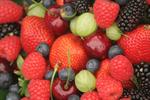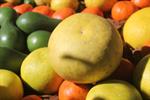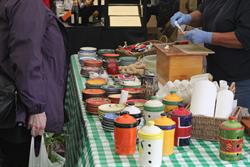COURSE STRUCTURE

The course is divided into six lessons as follows
1. Introduction
2. Soils, site preparation & planning.
3. General Cultural Practices
4. Tree Fruits
5. Nuts and Vines
6. Berries
WHAT YOU WILL DO IN THIS COURSE

- Contact Department of Agriculture in your state, to obtain all of the information you can within reason (e.g. leaflets, booklets, details about advisory services etc) which relate to fruit growing.
- Select part of a home garden where the owner would like to grow fruit. Consider the good and bad points about the site and the suitability of different types of fruits to the situation.
- Take a sample of soil from an area you might consider growing fruit in. Using the method set out in the gardening manual provided with the course, name the soil.
- Look at the buds on the wood of three different species of fruit. Draw what you see, and label where you think the buds are fruit buds, and where you think they are vegetative buds.
- Observe the way in which fruit trees are trained or pruned in your locality.
- Visit a local hardware store, nursery or irrigation shop and look at drip and micro irrigation equipment which is for sale. Take note of the various components of these systems, how they fit together and how they work.
- Identify pests and diseases in a garden which you have visited.
- Select 4 different fruits from those you have read about which are grown in your area. For each one, research which varieties of that fruit are commonly grown, and why they are grown.
- Plan the development of a berry growing area for a backyard. Contact companies, visit nurseries and check the availability, quality and prices of berry plants you would like to grow on your site (or proposed site). Work with an imaginary site if you do not have a real life situation to deal with.
Grow Fruit at Home for Year Round Consumption
There is nothing like fruit from your own garden. It’s quality and nutrition is generally better than fruit that you buy because it’s fresh (the food value can deteriorate as the fruit ages), and you can be certain about what chemicals it has, or has not been, exposed to. Apart from this, growing your own fruit is a lot of fun.
The trouble is, even just one mature fruit tree tends to give you so much fruit all at once that it’s difficult to know what to do with it. You can, of course, give some to friends, family and neighbours, and if you get organised, you might be able to swap. For example, you might grow the apples for the neighbourhood, and your neighbour grows the pears. Think about it: If everyone in your street put in a different fruit tree and shared the fruit around, you could all have fresh fruit for months on end!
Another alternative is to make your backyard hobby into a financial gain. Why not sell excess fruit at the local markets or at street stalls?
Our gardens tend to have an excess of fruit during late summer and autumn. At this time of year, nectarines, peaches, plums, grapes, apples and pears are often available in glut quantities.
There are, however, other ways of dealing with an excess of fruit, and turning it into something that you can use all year round. Bottling your excess fruit into jams, pickles, chutneys, sauces are just a few options.
BOTTLING
Preserves will normally keep for a minimum of 12 months at room temperature in a pantry. Containers must be sterilised before use to prevent contamination by bacteria and other micro-organisms.
How to sterilise jars or bottles:
- Wash thoroughly in hot water, invert and drain.
- Just before filling, place in a 40oC oven to warm up for 20-30 minutes.
- Remove and immediately fill with the preserve (while the jar is still hot). You should not put a hot preserve in a cold jar or a cold preserve in a hot jar.
- Tightly seal jar. Always use fresh rubber seals or new stainless steel lids. Spring clipped glass lid jars are very effective for home bottlers.
- For a finishing touch when the jar is cooled, you can turn the jar upside down and quickly dip it into melted wax. Stand jar upright and allow wax to set. Alternatively tie a coloured cheese cloth or coloured cloth around the lid.

MAKING JAM
A good jam should have the following characteristics:
- Be clear
- Retain the flavour of the fruit used
- Not be too sticky when scooped out of a jar with a spoon (it should slide off the spoon cleanly)
- Have a sparkling appearance
- Be solid, not runny
All jam making follows much the same procedure:
- Prepare the fruit (cleaning, hulling, removing stones, etc) and place it into a large pan.
- Add water if needed, and simmer the fruit gently until it is soft. Sometimes water is not needed but a little lemon juice will help the jam to set.
- Add the required amount of sugar (too taste), and stir over a low heat until the sugar has dissolved. Do not let the jam boil before the sugar dissolves, as this will cause crystalisation.
- Now allow the jam to boil rapidly, without stirring, until setting point is reached. This could take from 5 to 30 minutes depending on the fruit and the type of pan used.
- Allow the jam to cool for 5 to 15 minutes and stir it before placing into sterilised jars.
- Testing the fruit
Test any fruit you plan to use before making a batch of jam:
- Boil a sample of fruit in a little water until it is mushy.
- Add 1 teaspoon of the liquid into a glass jar and let it cool.
- When cool, add 2 teaspoons of methylated spirits and let it stand for 1 minute.
- If one or several large clots of jelly form, you should add 1 cup of sugar to every 1 cup of boiled-up fruit puree.
- If only flakes of jam appear you should use only 3/4 cups of sugar per cup of liquid.
- If there are few or broken flakes of jam, then the fruit does not contain sufficient pectin to set into a jam.
- Approximately 1 teaspoon of strained lemon juice can be added to every 1 kg of fruit to improve setting if pectin levels are insufficient.
WHAT SETS ACS APART?
At ACS we provide you with more than just a set of course notes.
Your 'learning package' includes:
- Course notes.
- Self-assessment quizzes.
- Assignment feedback.
- You can interact one on one with a professional tutor with decades of experience - just email, phone or log on to chat to connect with them.
- Depending upon your course, your studies may involve independent research, interviews, practical exercises, assessments, Problem Based Learning projects, and more.
WHAT NEXT?
Register to Study - Go to “It’s Easy to Enrol” box at the top of the page and you can enrol now.
or
Get Advice – Email us at info@acsedu.co.uk OR
Use our FREE COUNSELLING SERVICE to contact a tutor
CLICK TO CONTACT US